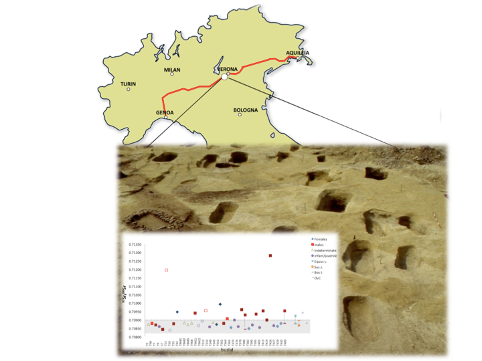
The Arrival of the Longobards in Italy: a Biomolecular Analysis
The great march of the Longobards in our peninsula began in 568 A.D., when the warriors with long beards began to press impressively at the gates of the Alps to conquer new lands.
Following the via Postumia, an ancient Roman road in northern Italy, they founded a series of settlements, including Povegliano Veronese, Verona, Italy, the burial area of which was subjected to numerous investigations during archaeological excavations carried out between the 1980s and 1990s.
A new paper, the result of a mission coordinated by Mary Anne Tafuri of the Laboratory of Paleoanthropology and Bioarchaeology of Sapienza, has reconstructed the dynamics through which the Longobards arrived in our peninsula after the fall of the Roman Empire and settled on the territory. The study has been published on Scientific Reports Journal.
The study, carried out in collaboration with the National Research Council of Italy (CNR), the University of Parma and the Catholic University of the Sacred Heart of Milan, is based on biomolecular analyses on remains of some of the individuals found in the Longobard necropolis of Povegliano Veronese. Its aim was to investigate the mobility of Germanic populations and the socio-cultural aspects that followed. Specifically, Mary Anne Tafuri and her team examined the concentration of strontium and oxygen and their stable isotopes (atoms with a variable mass number) inside bones and teeth of a "sample" of 39 buried individuals and 14 animals, selected among the finds that emerged from the necropolis.
Oxygen and strontium, like all natural elements, have a precise isotopic distribution that can be altered by biochemical and environmental factors. What is interesting is that values related to these alterations are specific of one geographical area rather than another.
"By detecting these biomolecular data,” says Mary Anne Tafuri, “we were able to highlight the heterogeneity of values within the sample and make a statistical subdivision into three "sub-populations", distinguished by different geochemical signatures: the natives, i.e. those who have spent their whole life in Povegliano Veronese; the allochthonous, who arrived in the area during their life and the outliers, individuals with values outside the variability observed in the first two groups."
Subsequently, the researchers investigated the origin and mobility dynamics of that part of the community, about 26%, who were not born in Povegliano but migrated there during their lifetime, comparing the isotopic data of this group with those of individuals from other Longobard necropolises. The isotopic values of the allochthons of Povegliano were compatible with those of the Longobards buried in the Hungarian necropolis of Szólád, one of the last locations occupied by the Longobards before their arrival in Italy, confirming the reconstruction carried out by the scholars.
Moreover, thanks to the data provided by the tomb structures where the individuals were found and the accompanying objects, it has been possible to distinguish between burials attributable to the most ancient phase of the necropolis (late sixth - early seventh century A.D.) and more recent ones (first half of the seventh - first half of the eighth century A.D.), i.e. between individuals belonging to the first and subsequent generations of settlers.
"We have shown that all the allochthonous individuals found in the burial area of Povegliano Veronese belonged to the first generations,” adds Mary Anne Tafuri, “as they were accompanied by items that can be dated back to the first phase of use of the necropolis, while the autochthonous ones, therefore born and dead in Povegliano, are characterised by later items."
The results of the study, which combines archaeological and isotopic data, constitute an important piece in the reconstruction of the dynamics of settlement and mobility of the Longobards as a whole. They also help explain how these warriors integrated into the context of civilisation, creating a new culture, capable of combining the Germanic tradition with the classical and Roman-Christian one.
References:
Strontium and oxygen isotopes as indicators of Longobards mobility in Italy: an investigation at Povegliano Veronese - Guendalina Francisci, Ileana Micarelli, Paola Iacumin, Francesca Castorina, Fabio Di Vincenzo, Martina Di Matteo, Caterina Giostra, Giorgio Manzi & Mary Anne Tafuri - Scientific Reports volume 10, Article number: 11678 (2020) DOI https://doi.org/10.1038/s41598-020-67480-x
Further Information
Mary Anne Tafuri
Departement of Environmental Biology
maryanne.tafuri@uniroma1.it
